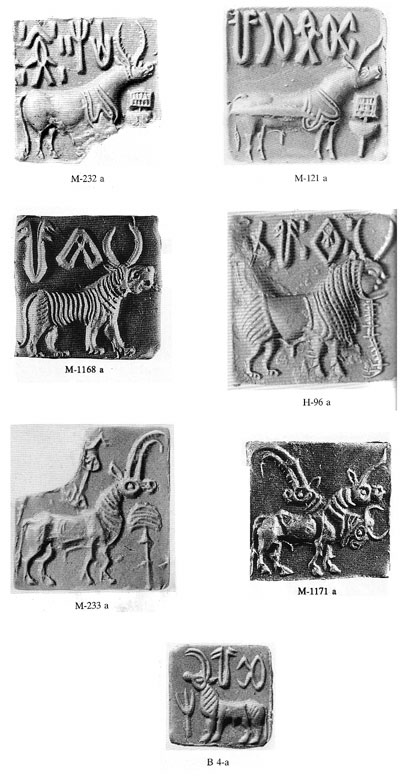Not Unicorns
Steve Farmer
Go to article downloads.
Below is visual evidence to illustrate a post I made on the private ScholarlyServices List (primarily made up of Indologists) on 3 April 2004. The original post, slightly edited, is included for convenience:
Naga Ganesan quotes Possehl on the unicorn:
pg. 131, G. Possehl, The Indus civ., a contemporary
perspective, 2002 “The Indus Unicorn: A real or “Fantastic” animal?
The question centers on whether this is a real
animal, with the single horn shown for purposes
of artistic perspective, or is it fantastic, a
creation of the Indus mind?… C. Grigson is a recent proponent
of the fantastic animal hypothesis, which is not
without merit. But most others, including Marshall
and Mackay, agree that “the artist intended to
represent one horn behind the other.” This point
of view is supported by the fact that there are
a few seals with unicorn-type bulls with two horns.
Greg’s citation of opposing “authorities” shouldn’t be mistaken for evidence. What he doesn’t tell you is that the few seal inscriptions that carry unicorn-type bulls that have two horns are very odd looking creatures that themselves look mythological — or weren’t intended to be “unicorns” at all.
Moving through the visual examples: M-232 a does have a typical unicorn’s body and carries the same pipal-leaf (?) or heart (?) decoration often found on unicorns. See M-121 a, which I put right next to it. But the two horns we see here are very special types of double horns that we commonly find only on Indus mythological creatures. Cf. the “tiger” with the same divine horns in M-1168 a (illustrated below) and the wild composite creature (a human’s face, an elephant’s trunk, an eagle’s or lion’s [?] back claws, and a unicorn’s body and front hooves) in H-96 a.
There are Harappan creatures with two horns that you might claim were unicorns with two horns, if you were a bit sloppy with the evidence. See here M-233 a below left. Joshi and Parpola label this an “urus” — the extinct auroch or bos primigenius — but how they came to that odd conclusion (check out the above link) is beyond me: It certainly looks mythological to my eyes. But, in any case, it cannot be claimed as a “unicorn with two horns,” since we see this creature plus the unicorn plus a bison in one of the neat three-headed creatures found occasionally on seals — e.g. in M-1171 a (symbol of a higher political union of three clans?).
Conclusion: pace Possehl, there is no evidence of “two horned unicorns” in the Indus corpus. The closest I can think of to these are some two-horned creatures found in boondock sites like Banawali (see, e.g., B-4 a, illustrated at the right). But the horns and many other details are wrong, and it looks much more like the so-called urus we find in M-233 a and a handful of other seals.

Feb 2023 format changes from web server migration.
